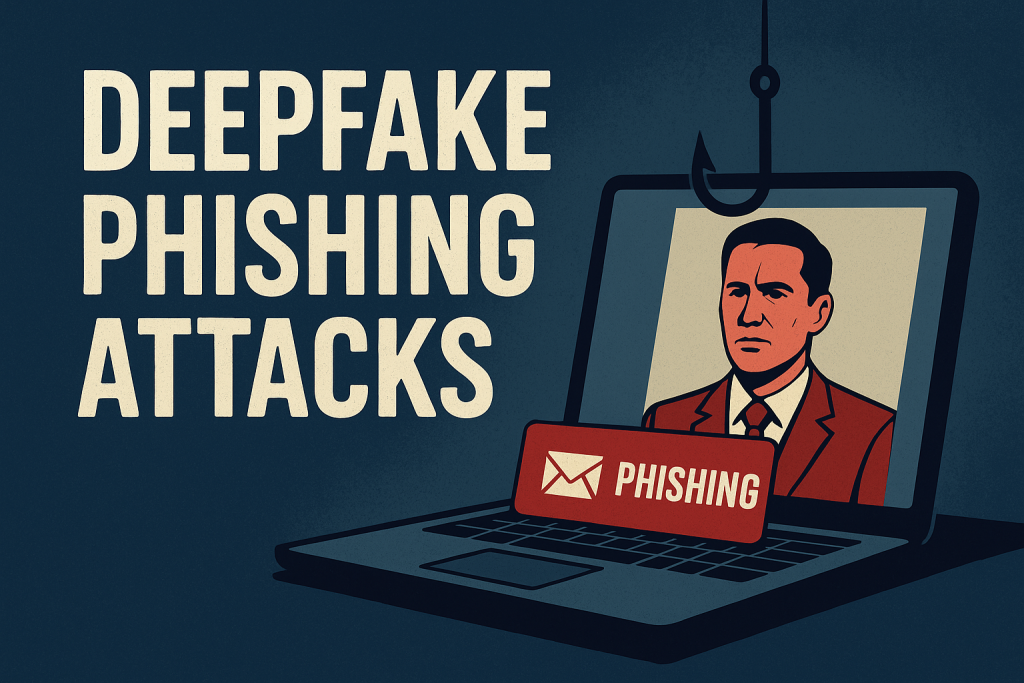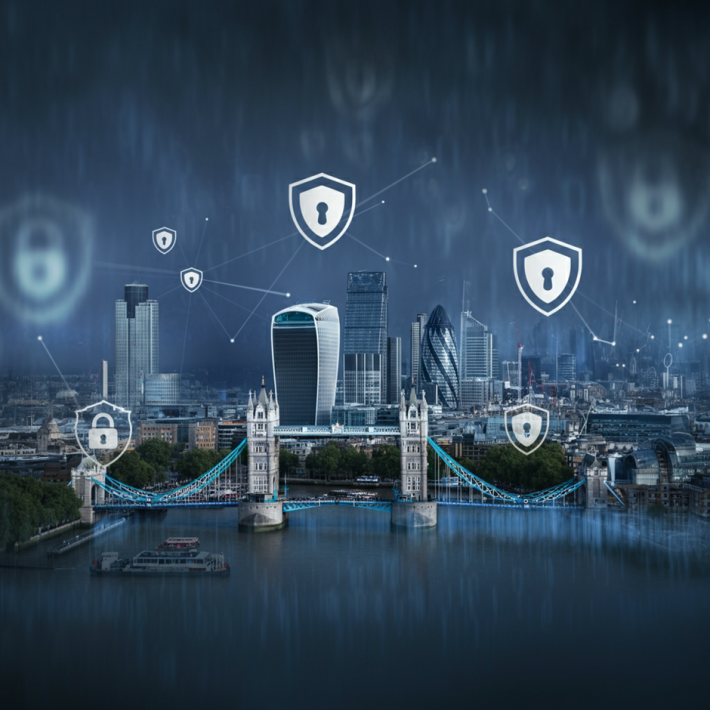Warning: Deepfake Phishing Attacks That Can Deteriorate Your Organization’s Data

Imagine this: your finance team receives an urgent voicemail from your CEO asking to transfer $250,000 for an unexpected acquisition. The voice is perfect. The tone matches. Even the background chatter feels familiar. But here’s the catch: the real CEO was on a flight halfway across the world.
This is not sci-fi. This is deepfake phishing, and it’s transforming cybersecurity threats in 2025. In a world where data is king, deepfake attacks are putting organizations at risk in ways old defenses simply can’t handle.

In the era of digitalization and digital attacks, both are increasing; data is very crucial for an organization. Companies rely on cybersecurity frameworks to defend against threats. But what happens when the attacker disguises itself so well that even the strongest defense mechanisms fail to recognize it
That’s the emerging danger of deepfake phishing attacks, a fresh kind of social engineering that makes use of synthetic media to mimic individuals with creepy precision. If routine phishing were a virus, then deepfake phishing is a wholesale mutation, smarter, more cunning, and significantly more lethal.:
Why Founders Should Care About Deepfake Phishing Attacks Right Now?
Startups and SMEs are under attack more than ever, and it’s not just hackers in hoodies using phishing kits. Deepfakes are emerging from generative AI and are now being weaponized at scale. Hackers can launch polished audio or video scams mimicking anyone from your C-suite, key vendors, or internal team members with eerie accuracy. Founders across Quora, Reddit, and LinkedIn report losing hundreds of thousands in single incidents because leadership impersonation attacks succeeded, even when employees felt “sure they recognized the voice.
What makes this threat so dangerous?
- People trust people. A familiar voice or face lowers suspicion instantly.
- No digital breadcrumbs. Traditional scanners can’t detect synthetic media until it’s too late.
Personalized and scalable. AI lets attackers replicate speech quirks, tone, and context for hundreds of employees simultaneously.
What Is Deepfake Phishing Exactly?
Deepfake phishing is usually followed up by combining AI-generated audio, video, or images with classic phishing strategies. It’s no longer about poorly worded emails from a “Nigerian prince” asking for money. We’re talking about hyper-realistic voicemails from your CEO, video messages from trusted clients, or even live calls mimicking your team members, all engineered to manipulate employees into clicking links, wiring funds, or sharing sensitive data.
Deepfakes are created using generative adversarial networks (GANs) and other machine learning models, making them harder to detect and easier to personalize
Why It’s a Bigger Threat Than Ever
simUphish is trusted by founders and security teams alike because it doesn’t just warn, it trains, detects, and deflects deepfake attacks before damage happens. Here’s how it empowers organizations across the board:
1. Realistic Deepfake Simulation Training
Benefit: Tests real employee behavior in lifelike scenarios before an actual attack hits.
Example: A technology startup once simulated a video call from the “CTO” asking for source code access. 70% fell for it. After running tailored training, that number fell below 5% in two simulated campaigns. That’s behavior change not just awareness.
2. AI-Powered Deepfake Detection Engine
Benefit: Analyzes voice and video content using contextual and linguistic modeling not just keywords or link detection.
Example: In one case, a marketing executive received a fictional CFO voicemail. simUphish flagged it instantly through tone analysis, avoiding a costly $100K wire transfer. The team discovered the attacker had used a deepfake voice tool.
3. Instant Alert & Response System
Benefit: Provides real-time alerts via Slack, Teams, or email when suspicious voicemails or videos arrive.
Example: At a mid-market healthcare group, an executive received a deepfake “client welcome video.” The alert triggered internal verification, and a single employee’s question prevented what could have been a compliance breach.
4. Voice Verification Protocols
Benefit: Executives can register unique voice signatures, simUphish matches live calls to these to spot imposters.
Example: A CFO accidentally registered with a slightly altered tone on launch day. simUphish rejected a real follow-up call due to mismatch allowing the security team to correct the registration before a real event.
Why These Features Matter
We’re not just chasing phishing clicks anymore. Deepfake simulations instill real empathy for suspicious behavior—turning users into defenders. It’s why SimuPhish achieves a 90% reduction in risk-prone behaviors within one quarter.
Trust, Verified
Trust in leadership voice or face is no longer enough. simUphish gives you verifiable signals, notifications, alerts, and prompts to second-check before acting on sensitive requests.
Executive Checked & Board Ready
Dashboards break down who clicked what and how the organization is trending at a high level. This data helps founders prove security maturity to investors, board members, and auditors.
Broader Impact of Deepfake Threats
Industry-wide, attackers are targeting high-stakes verticals—like finance, real estate, government, healthcare, and tech startups. Those sectors have seen $250K to $1M breaches from deepfake schemes alone.
Cybersecurity Ventures projects global cybercrime damages reaching $10.5 trillion by 2025, with deepfake phishing accounting for a rising share. (Recent reports suggest deepfakes will make up over 40% of social engineering attacks in high-value sectors by the end of 2025.)
Quick Checklist:
Question: Have employees been tested for deepfake voice/video phishing?
Actionable Insight: Conduct simulations in the past 6 months
Question: Can new deepfake threats be simulated in real time?
Actionable Insight: Use threat-fed template generation
Question: Are suspicious voice/video interactions verified before compliance?
Actionable Insight: Set up multi-factor voice authentication
Investing in a tool like simUphish isn’t just about reducing risk. It also brings tangible returns:
- Fewer breaches: Less downtime, less ransom paid, and no expensive PR nightmares.
- Compliance simplified: Facilitates fulfilling industry requirements
- Employee confidence: Individuals become your strongest defense, rather than your weakest link.
- The ROI of Cyber Immunity
Investing in a tool like simUphish isn’t just about reducing risk. It also brings tangible returns:
- Fewer breaches: Less downtime, less ransom paid, and no expensive PR nightmares.
- Compliance simplified: Facilitates fulfilling industry requirements
- Employee confidence: Individuals become your strongest defense, rather than your weakest link.
When Defense Fails, Recovery Is Costly
Cybersecurity Ventures analysed the fact that “Global cybercrime damages will reach $10.5 trillion annually by 2025”, based on the current trajectory of reported cyber attacks, and more stressingly is that the deepfake phishing will account for a significant portion of that, especially in industries like:
- Finance & Banking
- Real Estate
- Government & Defense
- Healthcare
- Tech startups
When a breach occurs, it’s not just the IT department that suffers. The whole organization feels it from legal and HR to sales and operations.
Is Your Organization Deepfake Proof?
Here’s a simple checklist to see where your organization stands:
- Do your employees know how to spot a deepfake voice or video?
- Have you run phishing simulations in the past 6 months?
- Is there a protocol to verify executive-level requests via voice/video?
- Are your digital tools able to detect synthetic media content?
- Do you have an internal alert system for suspicious behavior?
If you’ve checked fewer than 3, you’re vulnerable.
If it’s 0–1, the threat is already inside your walls.
Your People Are the Firewall, Make Sure They’re Ready
Deepfake phishing is different. It mimics trust with chilling accuracy, and when it succeeds, your defenses feel completely bypassed. Founders can no longer rely on filtered emails or antivirus software as their only safeguards. Building cyber resilience now requires human-centric detection, training, and context-aware threat recognition.
SimuPhish doesn’t just plug gaps; it strengthens your immune system. It makes your employees smarter than the attack methods of tomorrow.
Start simulating. Start securing. Build a culture where deception is checked and trust is verified.
Don’t wait for the “CEO” to call.
Start simulating. Start securing. Start with simUphish
Faq
- 1. Deepfake phishing: what is it?Deepfake phishing uses AI-generated speech, video, or photos in conjunction with conventional phishing techniques to pose as reliable people and trick targets into divulging personal information, sending money, or disclosing login credentials.
- 2. How are these deepfake attacks made by attackers?To make the impersonation convincing, they clone the voice, tone, facial expressions, and style using generative models like GANs and speech synthesis.
- 3. When compared to regular phishing, why is deepfake phishing more dangerous?Because it takes advantage of people's trust in voice and images, it is much more difficult to identify using standard filters that search for keywords or dubious links.
- 4. Why are organisations so susceptible?By imitating tone, context, and internal dynamics, attackers can scale their impersonations across a large number of employees, increasing the likelihood of success.
- 5. Can deepfake phishing be identified by standard email scanners?Usually not; deepfakes frequently get past typical filters, which concentrate on links, domains, or keywords rather than confirming the legitimacy of voices or faces.
- 6. In what ways does risk reduction come from simulation training?It reduces vulnerability to actual deepfake assaults by training staff to view speech and video requests with suspicion.
- 7. A voice signature protocol: what is it?In order to identify impersonators, executives register a vocal model or profile, which is then compared to incoming calls and videos in the future.
- 8. How soon after training may behaviour change occur?The case examples show that within a few simulated campaigns, risk-prone behaviour drastically decreased (for example, from over 70% to less than 5%).
- 9. What function do alerts in real time serve?They immediately flag questionable incoming media (voicemails, videos) for verification before taking action by sending it to certain teams (for example, using Slack or Teams).
- 10. Can non-executive staff members be the target of deepfake attacks?Indeed, any employee may be the target, but those with financial or sensitive system access are more vulnerable.
- 11. What warning signs should staff members be aware of?Any request that appears to be outside of regular protocol, including unusual haste, unexpected demands, strange wording, or mistimed requests.
- 12. Should secondary channels be used for verification at all times?Yes, it is crucial to confirm using reliable alternative methods, even if a voice or video appears authentic.
- 13. In what ways do dashboards and leadership visibility aid?They enable security teams to monitor who was duped by simulations, observe patterns over time, and demonstrate security maturity to interested parties.
- 14. Are facial or vocal cues still trustworthy?In order to enhance human judgement, organisations require technical and administrative safeguards once voice and face can be successfully reproduced.
- 15. How can deepfake phishing be prevented ethically using AI tools?By using AI to identify altered media, verify real voices or videos, and automate phishing response systems, technology can be used to protect rather than trick.
Follow Us for More Tips
Help others stay safe, too. Share this guide and follow SimuPhish for more real-time cybersecurity tips:
- Instagram: https://www.instagram.com/simuphish/
- Facebook: https://www.facebook.com/simuphish/
- LinkedIn: https://www.linkedin.com/company/sim-u-phish/
- Pinterest: https://www.pinterest.com/simuphish/





https://shorturl.fm/8jWR5
https://shorturl.fm/SZ2Q6
https://shorturl.fm/aFL1s
Здесь собрана актуальная и практичная сведения по многим вопросам.
Гости могут обнаружить ответы на актуальные темы.
Контент обновляются регулярно, чтобы вы могли читать новую аналитику.
Интуитивная организация сайта облегчает быстро выбрать нужные разделы.
порно
Разнообразие рубрикаторов делает ресурс универсальным для многих посетителей.
Любой сможет подобрать материалы, которые нужны именно ему.
Наличие практических рекомендаций делает сайт ещё более полезным.
Таким образом, этот ресурс — это удобный помощник актуальной информации для каждого пользователей.